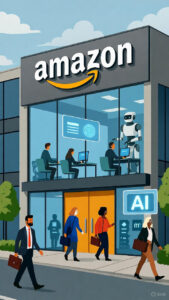
Introduction: Understanding the Scale of Amazon Layoffs
The Great Recalibration: Deconstructing the Scale, Strategy, and Human Impact of the 2025 Amazon Layoffs
The announcement of the Amazon layoffs in 2025 sent a seismic shockwave through the global economy, far beyond the typical business news cycle. These were not just another corporate downsizing. The Amazon layoffs represented a profound symbolic rupture, a definitive end to an era of unchecked, aggressive expansion that had defined the tech behemoth for over a decade. The image of Amazon as an unstoppable hiring machine, a voracious consumer of talent and a creator of countless jobs, was suddenly and starkly replaced by a new reality: one of consolidation, efficiency, and strategic retreat. The Amazon layoffs, affecting tens of thousands of employees worldwide, became a powerful symbol of a shifting economic paradigm, where the dual forces of post-pandemic normalization and the relentless march of artificial intelligence are forcing even the most dominant companies to fundamentally rethink their relationship with their workforce.
To understand the true magnitude and implication of the Amazon layoffs, one must look beyond the headlines and the raw numbers. This is a story of how a company grew to become one of the largest private employers on Earth, why that very scale became a liability, and how a confluence of strategic, technological, and economic pressures culminated in a necessary, yet painful, corporate course correction. The Amazon layoffs are a multi-faceted event, a case study in modern corporate strategy that offers critical lessons for employees, investors, competitors, and policymakers about the future of work in an age of automation.
Section 1: The Colossus – Understanding the Unprecedented Scale of Amazon’s Workforce
Before dissecting the Amazon layoffs, it is imperative to grasp the sheer scale of the entity in question. Amazon is not merely a tech company; it is a vast, interconnected ecosystem spanning e-commerce, cloud computing, digital streaming, artificial intelligence, logistics, and physical retail. This diversified empire is powered by a workforce of staggering size.
1.1 A Historical Perspective: From Garage to Global Colossus
Amazon’s growth trajectory is the stuff of business legend. From its humble beginnings in a garage in 1994, its employee count remained relatively modest for its first two decades, focused primarily on corporate and warehouse roles. The real inflection point began in the mid-2010s, as the company aggressively expanded its logistics network to fulfill its promise of rapid delivery.
- 2014: 154,000 employees
- 2018: 647,000 employees (a 320% increase in four years)
- 2020: 1,298,000 employees (doubling in just two years)
- 2021 (Peak): 1,608,000 employees
This data reveals a tenfold increase in just seven years. To put this in perspective, Amazon was adding the equivalent of the entire population of a mid-sized city to its payroll every year. This growth was not accidental; it was a strategic imperative to build a global infrastructure capable of dominating retail and beyond.
1.2 The Pandemic Supercharger: An Unprecedented Hiring Frenzy
The COVID-19 pandemic acted as a powerful accelerant on this already explosive growth. With brick-and-mortar retail shuttered and consumers fearful of in-person shopping, the world pivoted almost entirely to online channels. Amazon became the essential utility for a planet in lockdown.
To meet this tsunami of demand, the company embarked on a hiring spree of historic proportions. In 2020 alone, Amazon hired over 500,000 new employees. It opened new fulfillment centers, sortation hubs, and delivery stations at a breakneck pace. Its corporate divisions, particularly in tech, also swelled to build and support the scaling infrastructure. The company was effectively building an army to service a global economy that had been forcibly digitized overnight. At the time, it was hailed as a masterstroke, a demonstration of Amazon’s ability to scale and meet customer needs when it mattered most.
1.3 A Comparative Lens: Amazon vs. Its Tech Peers
The unique nature of Amazon’s business model is thrown into sharp relief when compared to its Big Tech counterparts. As of 2024, the employee counts tell a revealing story:
- Amazon: ~1.56 million employees
- Microsoft: ~228,000 employees
- Alphabet (Google): ~183,000 employees
- Meta (Facebook): ~87,000 employees
Amazon employs roughly ten times more people than Microsoft or Alphabet. This disparity stems from a fundamental difference in business models. While Microsoft and Google are primarily software and services companies, Amazon has an enormous physical footprint. Its logistics arm, which includes hundreds of fulfillment centers, a vast trucking fleet, and a growing air cargo network, is intensely human-labor-dependent. The Amazon layoffs, therefore, were always going to be more complex and impact a wider variety of roles than any downsizing at its peers, precisely because of this unique and massive scale.
Section 2: The Perfect Storm – The Multifaceted Causes Behind the Amazon Layoffs
The Amazon layoffs were not the result of a single failing but rather a “perfect storm” of interrelated factors. These can be categorized into five core drivers: pandemic over-hiring, a strategic push for efficiency, the integration of AI and automation, market performance pressures, and broader economic trends.
2.1 The Primary Driver: Pandemic Over-Hiring and the Post-Lockdown Hangover
The most significant and immediate cause of the Amazon layoffs was the dramatic miscalculation in long-term demand forecasting during the pandemic.
- Hiring for a World That No Longer Exists: Amazon’s leadership, like many others, operated on the assumption that the surge in e-commerce was a permanent step-change in consumer behavior. They built a workforce and infrastructure for a reality where online shopping would maintain its pandemic-era peak. However, as lockdowns lifted and vaccines rolled out, a powerful “reversion to the mean” occurred. Consumers, weary of isolation, flocked back to physical stores. They began spending more on experiences like travel and dining out, reducing their discretionary spending on goods.
- The Math Stopped Working: Amazon’s revenue growth, which had soared to 37% in 2020, plummeted to single digits by 2023. The company found itself with a cost structure built for 30%+ growth in a 7% growth environment. The massive workforce, once its greatest asset, became its biggest cost liability. Internal memos and reports from 2023 and 2024 consistently cited “over-hiring during the pandemic” as the single largest factor necessitating cuts. The company had hoped that natural attrition—the normal rate of employees leaving voluntarily—would correct the headcount, but turnover rates did not rise as anticipated, leaving the company with no choice but to conduct involuntary Amazon layoffs.
2.2 The Strategic Pivot: Andy Jassy’s “Do More With Less” and the War on Bureaucracy
Under the leadership of CEO Andy Jassy, who succeeded founder Jeff Bezos in 2021, a new mantra took hold: “Do more with less.” This was not merely a reaction to slowing growth but a proactive strategic shift.
- Organizational “Slimming”: Jassy and his executive team initiated a comprehensive review of all business units, mandating a reduction in “layers of management” and the removal of “organizational friction.” Over years of hyper-growth, Amazon had developed bureaucratic bloat, with complex reporting structures and redundant teams that slowed decision-making. The Amazon layoffs were, in part, a deliberate effort to re-flatten the organization and restore the agility and speed of a startup.
- Resource Reallocation to High-Priority Areas: The goal was not just to cut costs, but to reallocate those resources toward areas deemed critical for the next decade. This meant diverting capital and talent away from low-growth or experimental divisions and into high-priority bets like:
- Artificial Intelligence and Machine Learning: Core to everything from AWS to Alexa.
- Logistics Automation: Making the fulfillment network faster and cheaper.
- AWS Innovation: Maintaining dominance in the high-margin cloud sector against Microsoft Azure and Google Cloud.
- Kuiper Satellite Internet: A long-term bet on global connectivity.
The Amazon layoffs in non-core or underperforming divisions were a direct result of this strategic triage.
2.3 The Technological Disruptor: The Accelerating Impact of AI and Automation
While Amazon is careful to state that AI is not the primary cause of the Amazon layoffs, it is an undeniable and powerful contributing factor that is reshaping the very nature of work within the company.
- From Physical to Digital Labor: Amazon has been a leader in warehouse robotics for years, with systems like Kiva robots automating the movement of shelves. The new wave of AI goes much further. Sophisticated algorithms now handle complex tasks such as:
- Demand Forecasting: Predicting what products will be needed where, with stunning accuracy, reducing overstocking and optimizing inventory.
- Route Optimization: Planning the most efficient delivery routes for drivers, saving millions of miles and fuel.
- Automated Customer Service: AI-powered chatbots and systems now resolve a significant majority of customer inquiries without human intervention.
- The Double-Edged Sword of Innovation: This creates an uncomfortable paradox. The same technologies that drive Amazon’s efficiency, lower costs, and improve customer experience are the very ones that displace human roles. A task that required a team of ten analysts a week can now be done by one data scientist and an AI model in an hour. The Amazon layoffs in corporate, logistics planning, and support functions are a direct reflection of this productivity gain. The company is in the midst of a massive workforce transformation, where the demand for repetitive, process-oriented jobs is declining, while the demand for AI specialists, data engineers, and robotics maintenance experts is soaring.
2.4 Market Performance and Strategic Realignment
Not all parts of Amazon’s empire are created equal. The Amazon layoffs have been highly selective, targeting divisions where growth has stalled or profitability has been elusive.
- AWS (Amazon Web Services): Long the profit engine of Amazon, AWS has seen its growth rate slow from over 40% to the mid-teens as competition from Microsoft Azure and Google Cloud intensifies. This has triggered internal strategic reviews, leading to Amazon layoffs in marketing, sales, and even some engineering teams that were working on redundant or lower-priority projects within AWS.
- Devices and Services (e.g., Alexa): This division has been a particular focus of cost-cutting. Despite selling millions of Echo devices, the Alexa voice assistant has struggled to become a profitable platform. The “day one” mentality of funding long-term bets has been tempered by a new demand for financial discipline. As a result, teams working on Alexa and other hardware have faced significant restructuring and Amazon layoffs.
- Retail and International Operations: Some international markets have failed to achieve the scale necessary for profitability. Coupled with the post-pandemic normalization of e-commerce, this has led to consolidation and job cuts in various retail divisions across Europe and Asia.
2.5 The Broader Economic Climate: The End of “Growth at All Costs”
The Amazon layoffs cannot be divorced from the wider macroeconomic environment. The era of near-zero interest rates that fueled a decade of tech speculation is over.
- The “Efficiency” Wave: In 2022-2023, rising inflation and aggressive interest rate hikes by central banks made capital more expensive. Investors pivoted from rewarding top-line revenue growth to demanding profitability and free cash flow. This shift impacted the entire tech sector, leading to widespread layoffs at Meta, Google, Microsoft, and countless startups. Amazon’s actions are a part of this broader industry-wide movement toward “efficiency.” The narrative is no longer “growth at all costs” but “sustainable, profitable growth.”
- Return-to-Office as an Indirect Driver: Amazon’s firm stance on returning to the office (RTO) three days a week, while not officially a layoff program, created significant tension and contributed to voluntary attrition, particularly in corporate roles. Employees who had relocated or grown accustomed to remote work resisted the mandate, and some chose to leave rather than comply. This had a streamlining effect, effectively acting as a softer form of workforce reduction.
Section 3: The Human and Industry Impact – The Ripple Effects of the Amazon Layoffs
The consequences of the Amazon layoffs extend far beyond the company’s balance sheet, affecting individuals, the tech industry, and society at large.
3.1 Impact on Employees and the Labor Market
For the tens of thousands of individuals affected, the Amazon layoffs are a life-altering event.
- Shattered Job Security: The psychological contract between employer and employee, already weakened in the modern economy, has been further eroded. The notion that high performance guarantees job security has been proven false, as entire teams and divisions are eliminated for strategic reasons beyond any individual’s control.
- The Great Skill Shift: The Amazon layoffs are accelerating a necessary but painful shift in the skills demanded by the market. Employees with skills in legacy systems or in roles highly susceptible to automation are finding it harder to secure new positions. Conversely, there is a fierce war for talent in areas like AI, machine learning, and data science.
- The Rise of Adaptability: The key takeaway for workers is that adaptability and continuous learning are no longer optional; they are essential survival skills. The ability to pivot, upskill, and navigate a rapidly changing job market is the new currency of career stability.
3.2 Impact on the Global Tech Industry
As a bellwether, Amazon’s actions send powerful signals to the entire technology sector.
- Legitimization of Large-Scale Restructuring: The scale of the Amazon layoffs makes it acceptable, even expected, for other large firms to engage in similar deep cuts to “right-size” their organizations. It has become a standard tool in the corporate playbook.
- The AI Arms Race Intensifies: By reallocating resources toward AI, Amazon is forcing its competitors to do the same. The industry is now in a full-blown arms race to develop and implement generative AI, large language models, and automation technologies, a race that will likely lead to further workforce dislocations across the sector.
- Shift in Venture Capital and Startup Culture: The “growth at all costs” model for startups is now firmly out of favor. Investors are demanding clear paths to profitability, leaner operations, and more focused business models, mirroring the new discipline being exhibited by tech giants like Amazon.
3.3 Implications for Policymakers and the Future of Work
The Amazon layoffs present profound challenges for governments and societies.
- The Automation Dilemma: How do we manage the transition to a more automated economy without creating mass unemployment or underemployment? The Amazon layoffs are a stark preview of a trend that will affect many industries.
- The Need for Retraining and Education: There is an urgent need for robust, scalable public and private partnerships focused on workforce retraining. Traditional education systems are not moving fast enough to equip people with the skills needed for the jobs of the future.
- Potential for Regulatory Scrutiny: As one of the world’s largest employers engages in massive layoffs while simultaneously reporting strong profits in certain segments, it may attract scrutiny from lawmakers concerned about corporate power, labor rights, and the social contract.
Section 4: Lessons Learned and the Path Forward
The story of the Amazon layoffs is a cautionary tale with universal lessons.
4.1 Lessons for Corporations
- Hire for Adaptability, Not Just Scale: Companies must prioritize hiring versatile, resilient individuals who can grow and evolve with the company’s needs, rather than just filling a specific, static role.
- Plan for Contraction as Seriously as Expansion: Business continuity plans must include scenarios for downturns and strategic pivots. Assuming perpetual growth is a dangerous fallacy.
- Automate with a Human-Centric Strategy: Technology implementation should be viewed as a way to augment human capabilities, freeing employees for higher-value tasks, rather than simply as a tool for headcount reduction.
4.2 Lessons for Employees
- Own Your Career Development: Do not rely solely on your employer for training and career progression. Proactively seek out new skills, especially those related to emerging technologies.
- Cultivate a Robust Professional Network: In an uncertain job market, a strong network is one of the most valuable assets for finding new opportunities.
- Embrace a Mindset of Lifelong Learning: The concept of learning ending after graduation is obsolete. Continuous education, through online courses, certifications, and self-study, is the new norm.
Conclusion: Amazon Layoffs as a Defining Moment for the Next Decade
The Amazon layoffs of 2025 are far more than a corporate restructuring event. They are a defining moment that marks the end of one economic era and the beginning of another. They symbolize the transition from the physical-digital boom fueled by pandemic dynamics to a new age dominated by artificial intelligence, strategic focus, and financial discipline.
For Amazon, the amazon layoffs are a painful but necessary recalibration—a shedding of the excess weight gained during a period of unprecedented growth to become a leaner, more focused, and ultimately more resilient company for the challenges and opportunities of the next decade. For the rest of the world, they serve as a powerful and sobering reminder that in a capitalist system driven by innovation, creative destruction is an inherent and often brutal force. The jobs of yesterday are disappearing, and the jobs of tomorrow are being created. The ultimate challenge for individuals, companies, and societies will be to navigate this transition with wisdom, empathy, and a relentless commitment to adaptation. The Amazon layoffs are not a sign of Amazon’s demise, but a stark signal that the future of work is already here, and it demands a new playbook for survival and success.
🔗 External Source Reference:
For a deeper dive into the historical data and trends of Amazon’s workforce, you can explore the detailed charts and figures at Macrotrends: Amazon Number of Employees (2006–2024). This resource provides a clear visual representation of the explosive growth and subsequent contractions that set the stage for the 2025 events.

















Post Comment